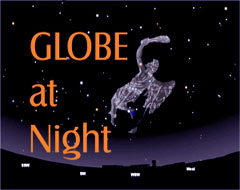Stars and STEM Stories
The 5th Annual GLOBE at Night Campaign

With half of the world's population now living in cities, many urban dwellers have never experienced the wonderment of pristinely dark skies and maybe never will. This loss, caused by light pollution, is a concern on many fronts: safety, energy conservation, cost, health and effects on wildlife, as well as our ability to view the stars. Even though light pollution is a serious and growing global concern, it is one of the easiest environmental problems you can address on local levels.
GLOBE at Night is an annual 2-week campaign in March that helps to address the light pollution issue locally as well as globally. This year the campaign will take place on 3-16 March 2010 from 8:00pm to 10:00pm local time. You are invited along with everyone all over the world to record the brightness of your night sky by matching its appearance toward the constellation Orion with star maps of progressively fainter stars found at http://www.globeatnight.org/observe_magnitude.html. You then submit your measurements on-line at http://www.globeatnight.org/report.html with your date, time and location. A few weeks later, organizers release a map of light-pollution levels worldwide. Over the last four 2-week GLOBE at Night campaigns, volunteers from over 100 nations have contributed 35,000 measurements.
To learn the five easy steps to participate in the GLOBE at Night program, see the GLOBE at Night Web site at http://www.globeatnight.org. You can listen to the 10-minute audio podcast on light pollution and GLOBE at Night at http://365daysofastronomy.org/2010/02/03/february-3rd-the-globe-at-night-campaign-our-light-or-starlight/
For activities that have children explore what light pollution is, what its effects are on wildlife and how to prepare for participating in the GLOBE at Night campaign, see the new activities at http://www.darkskiesawareness.org/DarkSkiesRangers.
Monitoring our environment will allow us as citizen-scientists to identify and preserve the dark sky oases in cities and locate areas where light pollution is increasing. All it takes is a few minutes during the March 2010 campaign to measure sky brightness and contribute those observations on-line. Help us exceed the 15,000 observations contributed last year. Your measurements will make a world of difference.
Read about the 2008 GLOBE at Night campaign.
23 February 2010





